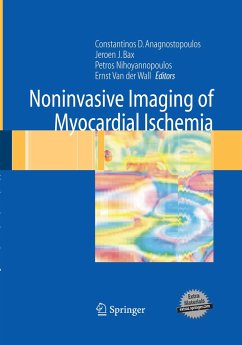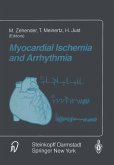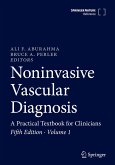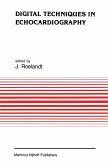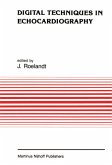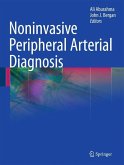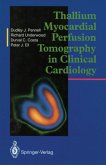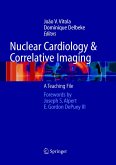Ischemic heart disease (IHD) is the main cause of morbidity and mortality in the developed world. Despite advances and new developments in primary and secondary prevention, the prevalence of the disease and its complications remain high. Early detection has been shown to reduce significantly the risk of cardiac events such as myocardial infarction and death, while modern cardiology now provides specialists and general physicians with a variety of procedures for the assessment of IHD using noninvasive methods. This book reviews the currently available imaging techniques for the diagnosis and management of IHD. In addition, the role of cardiac imaging for the detection of viability and hibernation is discussed in detail.
From the reviews:
Doody's Rating: 3 stars
Reviewer: Seth Jay Kligerman, MD, MS(University of Colorado School of Medicine)
Description: This book describes in detail the various imaging modalities used to evaluate myocardial ischemia. Additionally, the pathophysiology of myocardial ischemia is discussed in detail.
Purpose: The purpose of the book, according to the author, is to discuss the pathophysiology of myocardial ischemia as well as the various radiologic modalities used in its evaluation. These are worthy objectives, given the recent advances in the field over the past few years. The author meets his objectives.
Audience: According to the author, the book is written for any practitioner interested in noninvasive imaging of cardiac ischemia. I believe the book is intended primarily for nonradiologists interested in cardiac imaging. The authors are credible authorities.
Features: The first part of the book covers basic cardiac anatomy and physiology and the pathophysiology of myocardial ischemia. The second part covers the various imaging modalities (echocardiography, radionuclide imaging, CT, and MRI) used in the evaluation of myocardial ischemia. As a radiologist, I enjoyed the detailed discussion on the pathophysiology of myocardial ischemia. However, the book is limited in its discussion of MRI pulse sequences used in cardiac MR.
Assessment: Overall, this is an excellent book that provides a detailed look at the use of different radiologic imaging studies in the evaluation of myocardial ischemia. Additionally, the discussion on the pathophysiology of myocardial ischemia is a nice addition for radiologists and nonradiologists.
Score: Weighted Numerical Score: 84
"Noninvasive Imaging of Myocardial Ischemia is a concise review of current multimodality imaging techniques used for the evaluation of ischemic heart disease. The intended audience includes physicians and trainees involved in cardiac imaging, particularly radiologists, nuclear medicine physicians, and cardiologists. ... the book successfully gathers together a large amount of cardiac imaging research, digests it, and provides the reader with a concise picture of current utilization and future trends. I would recommend ... as a useful guide to the present status of the field." (Paul R. Jolles, Radiology, Vol. 244 (3), 2007)
Doody's Rating: 3 stars
Reviewer: Seth Jay Kligerman, MD, MS(University of Colorado School of Medicine)
Description: This book describes in detail the various imaging modalities used to evaluate myocardial ischemia. Additionally, the pathophysiology of myocardial ischemia is discussed in detail.
Purpose: The purpose of the book, according to the author, is to discuss the pathophysiology of myocardial ischemia as well as the various radiologic modalities used in its evaluation. These are worthy objectives, given the recent advances in the field over the past few years. The author meets his objectives.
Audience: According to the author, the book is written for any practitioner interested in noninvasive imaging of cardiac ischemia. I believe the book is intended primarily for nonradiologists interested in cardiac imaging. The authors are credible authorities.
Features: The first part of the book covers basic cardiac anatomy and physiology and the pathophysiology of myocardial ischemia. The second part covers the various imaging modalities (echocardiography, radionuclide imaging, CT, and MRI) used in the evaluation of myocardial ischemia. As a radiologist, I enjoyed the detailed discussion on the pathophysiology of myocardial ischemia. However, the book is limited in its discussion of MRI pulse sequences used in cardiac MR.
Assessment: Overall, this is an excellent book that provides a detailed look at the use of different radiologic imaging studies in the evaluation of myocardial ischemia. Additionally, the discussion on the pathophysiology of myocardial ischemia is a nice addition for radiologists and nonradiologists.
Score: Weighted Numerical Score: 84
"Noninvasive Imaging of Myocardial Ischemia is a concise review of current multimodality imaging techniques used for the evaluation of ischemic heart disease. The intended audience includes physicians and trainees involved in cardiac imaging, particularly radiologists, nuclear medicine physicians, and cardiologists. ... the book successfully gathers together a large amount of cardiac imaging research, digests it, and provides the reader with a concise picture of current utilization and future trends. I would recommend ... as a useful guide to the present status of the field." (Paul R. Jolles, Radiology, Vol. 244 (3), 2007)

